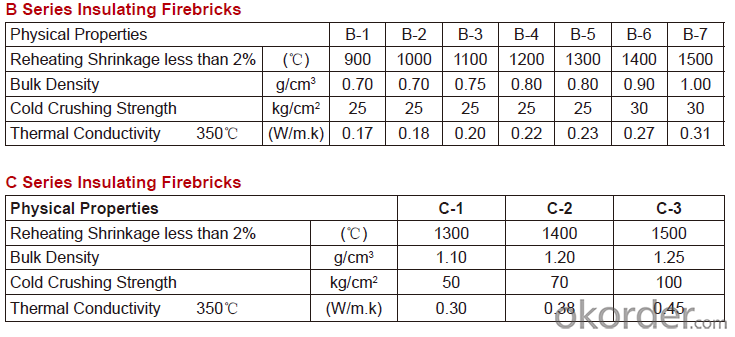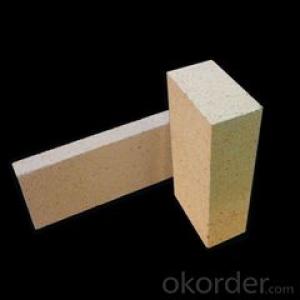Insulating Fire Brick - High Temperature Fireproof Fire Clay Refractory Heat Insulation Bricks for Thermal Equipment
- Loading Port:
- Shanghai
- Payment Terms:
- TT OR LC
- Min Order Qty:
- 1 m.t.
- Supply Capability:
- 1000 m.t./month
OKorder Service Pledge
OKorder Financial Service
You Might Also Like
Thermal Insulation Fire Clay Brick
Refractory brick is a block of refractory ceramic material used in lining furnaces, kilns, fireboxes, and fireplaces.
We provide high quality Refractory Fire Bricks that are used on wide range in the various industries like Cement, Glass and Steel. Refractory Fire Bricks are provided as per the quantity and specifications required by the customers. We provide an extensive range of Refractory Fire Bricks at reasonable prices that depend upon the quantity ordered.
Application
Insulating Fire Brick are used for the lining of converter, alternating current arc furnace, direct Current arc furnace and the ladle slag line, etc.
Company Advantage
(1)Long Insulating Fire Brick manufacture history: 25 years manufacturer
(2)Advanced equipment
(3)Diversification of production standards: ISO ANSI FEPA JIS ASTM
(4)Flexible payment: T/T L/C D/P D/A
(5)Professional marketing team and after-sale service
Insulating Fire Brick main feature:


Equipment
1 unit of Ceramic Abrasive (SG Abrasive) pilot production line
2 units of Compact grain Abrasive pilot production lines
1 unit of high-end coated abrasives (abrasive cloth) production line
2 units of Boron Carbide production lines
3 large flexible crushing and sieving lines for grit production lines
6 units of 5000KVA-10000KVA dumping type electric arc furnaces for Brown Fused Alumina fusion
Q1 What’s the transport method?
A1 FCL delivery goods with wooden pallet or wooden case by sea; If LCL delivery, must with wooden case; Sometimes need open top, flat rack or bulk cargo.
Q2 What’s the required payment term?
A2 Generally 30% TT as the prepayment, 70% TT before delivery. If need, 100% Irrevocable Letter of Credit or negotiation.
Q3 Which country are our products exported to?
A3 Apart from entire Chinese market, the US, Russia, Japan, Korea, Australia and some Southeast Asian Nations.


- Q: Can insulating fire bricks be used in biomass boilers?
- Yes, insulating fire bricks can be used in biomass boilers. These bricks are designed to withstand high temperatures and provide excellent insulation, making them suitable for use in biomass boilers where heat retention is crucial for efficient combustion.
- Q: Can insulating fire bricks be used in the construction of brick ovens?
- Brick ovens can indeed utilize insulating fire bricks. These specialized bricks possess exceptional thermal insulation characteristics, which make them highly suitable for applications that require efficient heat retention, such as brick ovens. Crafted from lightweight refractory materials, these bricks exhibit a lower density compared to standard clay bricks, thereby minimizing heat loss and enhancing energy efficiency. When constructing a brick oven, it is crucial to contemplate the insulation layer responsible for preserving and evenly disseminating heat throughout the oven. Insulating fire bricks can be employed to create this insulation layer, typically positioned between the inner cooking chamber and the outer oven layer. By utilizing these bricks, heat transfer to the outer layer is minimized, preventing excessive heat dissipation and ensuring the oven attains and maintains the desired high temperatures essential for baking or cooking. Apart from their impressive thermal insulation properties, insulating fire bricks also exhibit remarkable resistance to thermal shock. This signifies their ability to endure abrupt temperature changes without cracking or fracturing. This quality is particularly valuable in brick ovens, as they frequently encounter significant temperature fluctuations during the baking process. To sum up, insulating fire bricks are a fitting and highly recommended choice for constructing brick ovens due to their thermal insulation properties, lightweight composition, and resilience to thermal shock. By utilizing these bricks, a well-insulated and efficient oven can be created, capable of achieving and sustaining high temperatures for optimal baking or cooking outcomes.
- Q: Are insulating fire bricks resistant to cracking?
- Insulating fire bricks are specifically designed to have a high resistance to cracking. They are made from lightweight ceramic materials that have low thermal conductivity and high thermal shock resistance. These properties enable the bricks to withstand rapid temperature changes without cracking. Additionally, insulating fire bricks undergo a firing process that strengthens their structure and minimizes the risk of cracking. However, it is important to note that extreme thermal shock or physical impact can still potentially cause cracking in insulating fire bricks, so proper handling and installation techniques should be followed to ensure their longevity and effectiveness.
- Q: How do insulating fire bricks affect the overall thermal efficiency of a building?
- Insulating fire bricks can have a significant impact on the overall thermal efficiency of a building. These bricks are designed to have low thermal conductivity, meaning they are effective in reducing heat transfer between different areas of a building. By using insulating fire bricks in the construction of walls, ceilings, and floors, the thermal energy generated within the building can be better retained and distributed. This results in reduced heat loss during colder months and decreased heat gain during warmer months, ultimately leading to improved energy efficiency. Furthermore, the insulation provided by these fire bricks helps to create a more comfortable indoor environment by minimizing temperature fluctuations and reducing the need for excessive heating or cooling. This can result in lower energy consumption and cost savings for the building's occupants. In addition to their thermal insulation properties, insulating fire bricks also have other advantages. They are lightweight, which makes them easier to handle and install. They are also highly durable and resistant to thermal shock, making them ideal for applications where high temperatures are involved, such as fireplaces or kilns. Overall, incorporating insulating fire bricks into the construction of a building can greatly enhance its thermal efficiency, leading to improved energy savings, reduced environmental impact, and increased comfort for its occupants.
- Q: Can insulating fire bricks be used for insulation in power plants?
- Yes, insulating fire bricks can be used for insulation in power plants. Insulating fire bricks are designed to have excellent thermal insulation properties, which make them suitable for high-temperature applications. They can withstand extreme temperatures and provide effective insulation to prevent heat loss and increase energy efficiency in power plant operations. The insulating fire bricks are often used in various areas of power plants, such as furnaces, boilers, kilns, and chimneys. They can be used to line the walls, floors, and roofs of these structures to reduce heat transfer and maintain the desired temperatures inside the equipment. In power plants, insulating fire bricks help to minimize heat loss, improve combustion efficiency, and reduce thermal stress on the equipment. By providing a barrier against heat transfer, they help in conserving energy and reducing operational costs. Additionally, the insulation properties of these bricks also contribute to a safer working environment for power plant personnel. It's worth noting that while insulating fire bricks are suitable for insulation in power plants, they should be selected carefully based on the specific requirements and conditions of the power plant. Factors such as the operating temperature, chemical exposure, and mechanical stress should be considered to ensure the bricks can withstand the harsh conditions and provide long-lasting insulation performance.
- Q: Are insulating fire bricks resistant to reducing atmospheres?
- Insulating fire bricks exhibit resistance to reducing atmospheres. These bricks have been specifically engineered to endure elevated temperatures and harsh circumstances, including exposure to reducing atmospheres. They are crafted from top-notch refractory materials that possess the capability to withstand the detrimental effects of reducing atmospheres, which may encompass gases like carbon monoxide or hydrogen. Due to their low thermal conductivity and superior insulation properties, insulating fire bricks prove to be exceptional in scenarios where reducing atmospheres are present. They efficiently shield the surrounding areas from heat transfer and safeguard the structure against potential harm. Furthermore, these bricks boast remarkable mechanical strength and outstanding resistance to thermal shock, enabling them to retain their integrity even in the face of challenging conditions. In conclusion, the durability of insulating fire bricks coupled with their capacity to endure high temperatures and harsh environments confirms their resistance to reducing atmospheres.
- Q: Are insulating fire bricks resistant to hydrofluoric acid?
- Insulating fire bricks are not resistant to hydrofluoric acid. Hydrofluoric acid is a highly corrosive substance that can attack and dissolve many materials, including fire bricks. It is important to handle hydrofluoric acid with extreme caution and use appropriate protective equipment when working with this hazardous substance.
- Q: Do insulating fire bricks have a high heat storage capacity?
- Yes, insulating fire bricks have a high heat storage capacity. Insulating fire bricks are specifically designed to have low thermal conductivity, which means they are able to retain heat for longer periods of time. This makes them ideal for applications where heat storage is necessary, such as in furnaces, kilns, and other high-temperature environments. The high heat storage capacity of insulating fire bricks allows for efficient heat retention and distribution, ultimately improving energy efficiency and reducing heat loss.
- Q: Can insulating fire bricks be used in boilers for residential heating?
- Insulating fire bricks can indeed be utilized for residential heating boilers. These bricks are specifically engineered to endure elevated temperatures and offer superior thermal insulation properties. Their utilization in boiler and furnace construction is widespread due to their remarkable heat retention capabilities and ability to prevent heat dissipation. Consequently, the incorporation of these bricks aids in enhancing the energy efficiency of the boiler system by minimizing heat transfer to the surroundings, resulting in more effective heating and reduced energy consumption. Furthermore, the durability and resistance to thermal shock exhibited by insulating fire bricks make them ideal for withstanding the intense temperatures and rapid temperature fluctuations typically encountered in boilers. Consequently, their implementation in residential heating boilers serves to enhance both performance and energy efficiency.
- Q: Can insulating fire bricks be used in cement kilns?
- Indeed, in cement kilns, insulating fire bricks find their utility. These bricks are specifically engineered with a low thermal conductivity, rendering them an excellent choice for insulating environments that endure high temperatures, like cement kilns. By employing these bricks, heat loss can be minimized, thereby enhancing energy efficiency within the kiln. Furthermore, their lightweight composition facilitates ease of handling and installation in the kiln. Nevertheless, it is crucial to carefully select insulating fire bricks that align with the unique operating conditions and demands of the cement kiln to guarantee utmost performance and durability.
Send your message to us
Insulating Fire Brick - High Temperature Fireproof Fire Clay Refractory Heat Insulation Bricks for Thermal Equipment
- Loading Port:
- Shanghai
- Payment Terms:
- TT OR LC
- Min Order Qty:
- 1 m.t.
- Supply Capability:
- 1000 m.t./month
OKorder Service Pledge
OKorder Financial Service
Similar products
Hot products
Hot Searches
Related keywords
































